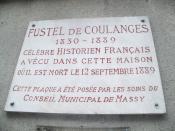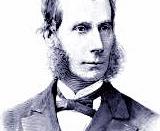Ancient and Modern Religious Liberty Liberty is a concept, which has been redefined for centuries. Most citizens of modern states regard liberty as being necessary to their livelihood, because it defines their rights. Since, the liberty of ancient citizens is different from the understanding of liberty today, most modern citizens would not even recognize it to be liberty. Fustel de Coulanges and Constant are two influential political scientists that discuss the differences between ancient and modern liberty. Both philosophers agree that the idea of modern liberty has evolved from ancient liberty into a completely different idea. The idea of religious liberty is an important aspect of liberty that has changed significantly from the time of the ancients to modernity.
Religious liberty, as it is today, was nonexistent to the ancients; instead, their religious liberty consisted only of their participation in religious ceremonies of their cities. Constant claims that the ancients gave ?no importance to individual independence, neither in relation to opinions, nor to labour, nor, above all, to religion.
The right to choose one?s own religious affiliation, a right which we regard as one of the most precious, would have seemed to the ancients a crime and a sacrilege? (Constant 311). Fustel de Coulanges agrees with Constant, he states that it is a human error ?to believe that in the ancient cities men enjoyed liberty. They had not even the idea of it.
They did not believe that there could exist any right as against the city and its gods? (Fustel de Coulanges 215).
The ancient understanding of religious liberty can be best understood if one understands the way in which, ancient society developed. Ancient religion was originally family based. They believed that when one died that their spirit had to be taken care of by their families. Therefore, each family worshiped their dead; this was the way in which they cared for their souls. Even though the ancients worshiped the dead it was actually ?nothing more than the worship of ancestors? (Fustel de Coulanges 27). Since each family had their own gods, they were the only ones who were allowed to worship those particular gods. The reason they did not allow people outside the family to worship with them was because ?the presence of one who was not of the family disturbed the rest of the manes. The law therefore, forbade a stranger to approach a tomb? (Fustel de Coulanges 26-27). Since religion was family based, the father of each family was the priest. He was in charge of the scared fire and all of the religious ceremonies that took place in the family?s home every day. By religion being domestically based, there were no ties between families, because nothing existed to make that connection. This family based religion ?forbade two families to mingle and unite; but it was possible for several families, without sacrificing anything of their special religions, to join, at least, for the celebration of another worship which might have been common to all of them? (Fustel de Coulanges 110).
After some time, families ?conceived the idea of a divinity superior to that of the household, one who was common to all, and who watched over the entire group? (Fustel de Coulanges 110). This new understanding resulted in the formation of tribes and, ?the tribe, like the family was established as an independent body, since it had a special worship from which the stranger was excluded (Fustel de Coulanges 118).? Because religion was still the main focus of these tribes, each tribe had a scared fire and believed that there was a god that watched over them, very similar to the family religion. The god of the tribe ?was a man deified, a hero,? (Fustel de Coulanges 112) and from the tribe; therefore, their religion was still based upon ancestor worship. Then the ancients started creating gods of the physical nature, and these were the gods that all the members of the tribe held in common.
Since they had these gods of the physical nature in common, the tribes started forming alliances among each other. ?The day on which this alliance took place the city existed (Fustel de Coulanges 119).? Each city had a founder who became the high priest, like the father in the family religion, and the king of the city. ?The founder was the man who accomplished the religious acts without which a city could not exist. He established the hearth where the sacred fire was eternally to born. He it was, who, by his prayers and his rites, called the gods, and fixed them forever in the new city (Fustel de Coulanges 134).? After a city was formed, it did not grow or allow other people to become citizens. This was because ?gods were attached to a city forever, so the people could never again abandon a place where their gods were established? (Fustel de Coulanges 133). The formation of a city was a ?a sort of contract between gods and men? (Fustel de Coulanges 133); which therefore, meant that men were not free to leave and join cities as they chose. Since, the city was established like the family, each city had its own scared fire with a scared hearth. The founder of the city took care of this scared fire just as the father took care of the scared family fire. Since, all cities were founded and based on religion, each city had many gods that watched over it but each city had one god that was unique just for them. This resulted in a lack of ties between the cities. All city functions were religious functions; each had a religious ceremony that went along with it. All of the city?s religious practices were put into the law; therefore, religious tradition and law were one in the same.
It is hard for the moderns to understand religious liberty in the same manner as the ancients, because religion is no longer a foundational element of the city. In ancient times, religion was an integral part of the city, and if someone was not participating in religion, then they were not participating in the city?s functions. To be a citizen of the city, one would have to partake in the religious ceremonies of the city, because the religious ceremonies were the most important part of the ancient city. The end of the ancient?s understanding of religious liberty started with the founding of Christianity.
?The victory of Christianity marks the end of ancient society? (Fustel de Coulanges 381), and this is because Christianity universalized religion. Christianity created one loving God that all men were able to worship and love. The idea of one God was unheard of in the ancient city, because each city was founded upon a personal god; and therefore, each city had to have at least one god that was unique just to it. Christianity changed that idea, because it allows every city to worship the same God. Having a universal God allowed for the cities to create ties between them. The new modern states were no longer defined by religion but rather by the type of regime that governed it.
Along with this new understanding of religion, came a new understanding of religious liberty. The modern understanding of religious liberty differs greatly from that of ancient religious liberty. Since cities no longer are founded on religious standings, there is now more religious liberty granted to the citizens of a city or state. The modern state also divided the church from the state, and this too allows the state to grant its citizens religious liberty. According to the moderns, liberty is ?the right to be subjected only to the laws, and to be neither arrested, detained, put to death or maltreated in any way by the arbitrary will of one or more individuals? (Constant 310). Moderns also believe that they have the liberty to ?profess the religion which they and their associates prefer? (Constant 311). This understanding of religious liberty is significantly different from what the ancients believed to be their religious liberty.
The existence of these contrasting views of liberty can be explained through an understanding of ancient and modern religious liberty. Constant summarizes the differences as such: ?the aim of the ancients was the sharing of social power among the citizens of the same fatherland: this is what they called liberty. But the aim of the moderns is the enjoyment of security in private pleasures; and they call liberty the guarantees accorded by institutions to these pleasures (Constant 317).? From this, we can conclude that moderns view their religious liberty as the ability to practice whatever religious practices they choose, whereas, the ancients believed that their religious liberty came from the right of just being able to partake in the religious affairs of their city.




